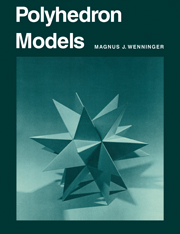Book contents
- Frontmatter
- Dedication
- Contents
- Preface to 1978 reprint
- Preface
- Foreword
- Introduction: uniform polyhedra
- Mathematical classification
- Section I The Convex Uniform Polyhedra: The Platonic and Archimedean Solids
- Section II Some Stellations and Compounds
- Section III Non-convex Uniform Polyhedra
- Commentary
- General instructions for making models of non-convex polyhedra
- Non-convex polyhedra (67–109)
- Commentary on non-convex snub polyhedra
- Non-convex snub polyhedra (110–119)
- A final comment
- Epilogue
- References
- List of models
Commentary on non-convex snub polyhedra
from Section III - Non-convex Uniform Polyhedra
Published online by Cambridge University Press: 05 August 2015
- Frontmatter
- Dedication
- Contents
- Preface to 1978 reprint
- Preface
- Foreword
- Introduction: uniform polyhedra
- Mathematical classification
- Section I The Convex Uniform Polyhedra: The Platonic and Archimedean Solids
- Section II Some Stellations and Compounds
- Section III Non-convex Uniform Polyhedra
- Commentary
- General instructions for making models of non-convex polyhedra
- Non-convex polyhedra (67–109)
- Commentary on non-convex snub polyhedra
- Non-convex snub polyhedra (110–119)
- A final comment
- Epilogue
- References
- List of models
Summary
There are two convex snub polyhedra, the snub cube and the snub dodecahedron. Among the non-convex polyhedra there are at least nine, ten if you count 119, which is rather different from the others. The snub quality manifests itself in the two convex cases, in the twisted way in which the squares and pentagons are related to a circumscribing cube and dodecahedron respectively. The twist introduces dextro and Iaevo, right and left-handed varieties in each case, and also a special set of triangular faces, the snub triangles. The same twisted characteristic is found in the non-convex cases and also sets of snub triangles. Model 119 is special in that the diametral squares may be considered as the snub faces.
The patterns on the facial planes of these non convex snubs are tantalizingly irregular. None of the usual symmetry manifests itself, except, surprisingly enough, in 110 which is very simple and in 118 which is very complex. Because of this lack of facial symmetry (the solids as such have rotational symmetry), the intersections of the facial planes determining the pattern on these faces can only be found by calculation. This involves the use of analytic or coordinate geometry. The use of the usual Euclidean tools, ruler and compasses alone, will not suffice
Mr R. Buckley of Windsor, Berks, England, has recently performed these calculations, obtaining all the numerical data by programming a computer to work out the analytic equations. Briefly stated, his method involves a system of spherical coordinates, the polar axis being along an axis of rotational symmetry and the zero meridian through a vertex of the polyhedron. Then with right and left specified, polar coordinates for all vertices can be calculated. These are translated into the usual Cartesian coordinates to obtain equations for the facial planes. Then the line of intersection of a pair of facial planes is readily obtained by solution of a system of equations. The computer supplied numerical results correct to six significant figures. For the purposes of model-making this degree of accuracy is unnecessary.
- Type
- Chapter
- Information
- Polyhedron Models , pp. 171Publisher: Cambridge University PressPrint publication year: 1971



